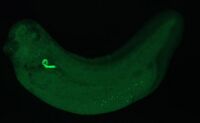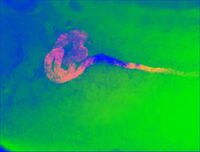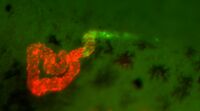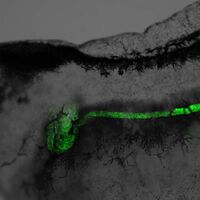Fluorescent In-Situs and FCIS (Vize lab): Difference between revisions
imported>Xenbase No edit summary |
imported>Xenbase No edit summary |
||
| Line 6: | Line 6: | ||
These pages contain protocols for performing wholemount fluorescent in situs. Instructions for two-color FISH and for a combination of fluorescent and colorimetric in situs we have called FCIS. Data can be imaged with a fluorescence stereoscope or a confocal. | These pages contain protocols for performing wholemount fluorescent in situs. Instructions for two-color FISH and for a combination of fluorescent and colorimetric in situs we have called FCIS. Data can be imaged with a fluorescence stereoscope or a confocal. | ||
*[[ | *[[FISH_/_Double_FISH|FISH protocol]] | ||
*Fluorescein tyramide synthesis | *[[Flourescin_Tyramide_Synthesis|Fluorescein tyramide synthesis]] | ||
*Cy3 tyramide synthesis | *[[Cy3_Tyramide_Synthesis|Cy3 tyramide synthesis]] | ||
*FCIS protocol | *[[FCIS|FCIS protocol]] | ||
FISH is not as sensitive as standard BM purple in situs, so if you have a very low abundance message it may not be detectable via fluorescence. You can however do a normal purple development for your low expression gene and a fluorescent counterstain- then overlay them to generate a FCIS image. These are both pretty and very good at highlighting quite subtle overlap | FISH is not as sensitive as standard BM purple in situs, so if you have a very low abundance message it may not be detectable via fluorescence. You can however do a normal purple development for your low expression gene and a fluorescent counterstain- then overlay them to generate a FCIS image. These are both pretty and very good at highlighting quite subtle overlap | ||
Revision as of 13:12, 22 December 2009




These pages contain protocols for performing wholemount fluorescent in situs. Instructions for two-color FISH and for a combination of fluorescent and colorimetric in situs we have called FCIS. Data can be imaged with a fluorescence stereoscope or a confocal.
FISH is not as sensitive as standard BM purple in situs, so if you have a very low abundance message it may not be detectable via fluorescence. You can however do a normal purple development for your low expression gene and a fluorescent counterstain- then overlay them to generate a FCIS image. These are both pretty and very good at highlighting quite subtle overlap
Papers and other sites:
Zhou, X. and Vize, P.D. (2004). Proximo-distal specialization of epithelial transport processes within the Xenopus pronephric tubules. Developmental Biology 271: 322-338.